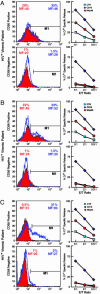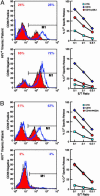Characterization of CD56-/CD16+ natural killer (NK) cells: a highly dysfunctional NK subset expanded in HIV-infected viremic individuals
- PMID: 15699323
- PMCID: PMC549494
- DOI: 10.1073/pnas.0409872102
Characterization of CD56-/CD16+ natural killer (NK) cells: a highly dysfunctional NK subset expanded in HIV-infected viremic individuals
Abstract
Natural killer (NK) cells are an important component of the innate immune response against viral infections. NK cell-mediated cytolytic activity is defective in HIV-infected individuals with high levels of viral replication. In the present study, we examined the phenotypic and functional characteristics of an unusual CD56(-)/CD16(+) (CD56(-)) NK subset that is greatly expanded in HIV-viremic individuals. The higher level of expression of inhibitory NK receptors and the lower level of expression of natural cytotoxicity receptors observed in the CD56(-) NK fraction compared with that of CD56(+) NK cells was associated with extremely poor in vitro cytotoxic function of this subset. In addition, the secretion of certain cytokines known to be important in initiating antiviral immune responses was markedly reduced in the CD56(-), as compared with the CD56(+) NK cell subset. These data suggest that the expansion of this highly dysfunctional CD56(-) NK cell subset in HIV-viremic individuals largely accounts for the impaired function of the total NK cell population.
Figures



References
-
- Karre, K., Ljunggren, H. G., Piontek, G. & Kiessling, R. (1986) Nature 319, 675–678. - PubMed
-
- Moretta, A. (2002) Nat. Rev. Immunol. 2, 957–964. - PubMed
-
- Raulet, D. H. (2004) Nat. Immunol. 5, 996–1002. - PubMed
-
- Moretta, A., Bottino, C., Vitale, M., Pende, D., Biassoni, R., Mingari, M. C. & Moretta, L. (1996) Annu. Rev. Immunol. 14, 619–648. - PubMed
MeSH terms
Substances
LinkOut - more resources
Full Text Sources
Other Literature Sources
Medical
Research Materials

